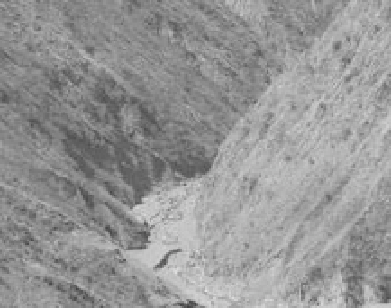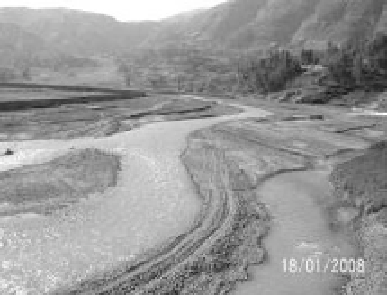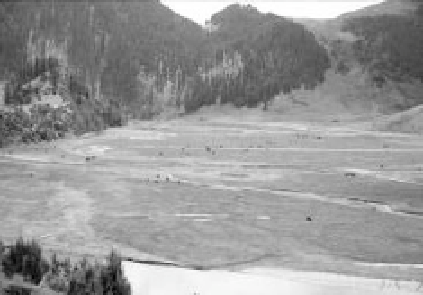Environmental Engineering Reference
In-Depth Information
(a) (b)
(c) (d)
Fig. 3.11
(a) A tributary of the Minjiang River in the rapid degradation stage; (b) the Dajinchuan River in the
degradation and widening stage; (c) the Kuaihe River in the upper Yangtze River basin in the aggradation and
widening stage; (d) an upstream reach of the Dahu River in the equilibrium stage (See color figure at the end of this topic)
forms associated with the evolution of incised channels is accompanied by related changes in the
character and quantity of riparian vegetation (Hupp and Simon, 1991; Hupp, 1992; Simon and Hupp,
1992; Hupp, 1997). Riparian vegetation may be directly removed by a disturbance or by mass failures
during channel adjustment. Re-establishment of woody vegetation on the banks of incised channels
generally occurs initially on low-bank surfaces and is accompanied by reworking of failed materials and
fluvial deposition (Simon and Hupp, 1986; Hupp and Simon, 1991). This is an indication that relative
stability is returning to the stream bank as vegetation extends upslope with time.
Vegetation increases flow resistance on bank surfaces and can result in locally reduced velocities and
enhanced deposition. In contrast, vegetation either germinated in situ, or delivered with a failure block to
a low-bank position, can cause eddying, flow deflection, and basal erosion of bank toes of the opposite
bank or bar. Riparian vegetation also has a variety of effects on the shearing resistance of stream banks
through its effects on root reinforcement (Wu and McKinnell, 1976), permeability (Collison and
Anderson, 1996), and pore-pressure distributions (Huck et al., 1970), and increases in shear strength due
to increased suction. Figure 3.12 shows the riparian vegetation by a small river in the Mississippi River
drainage basin resisting bank erosion with the roots of the trees bonding the bank soil. Reinforcement of
the shearing resistance of stream banks by roots is of course limited to the rooting depth of the riparian
vegetation. Field studies have shown that roots with diameters greater than 15 to 20 mm do not greatly
contribute to increased shear strength (Coppin and Richards, 1990). Large roots are better treated as soil
anchors (Gray and Leiser, 1982). The effects of riparian vegetation on deep-seated rotational or other
failures where the failure-plane depth exceeds the rooting depth is, therefore, limited to creating a





Search WWH ::

Custom Search